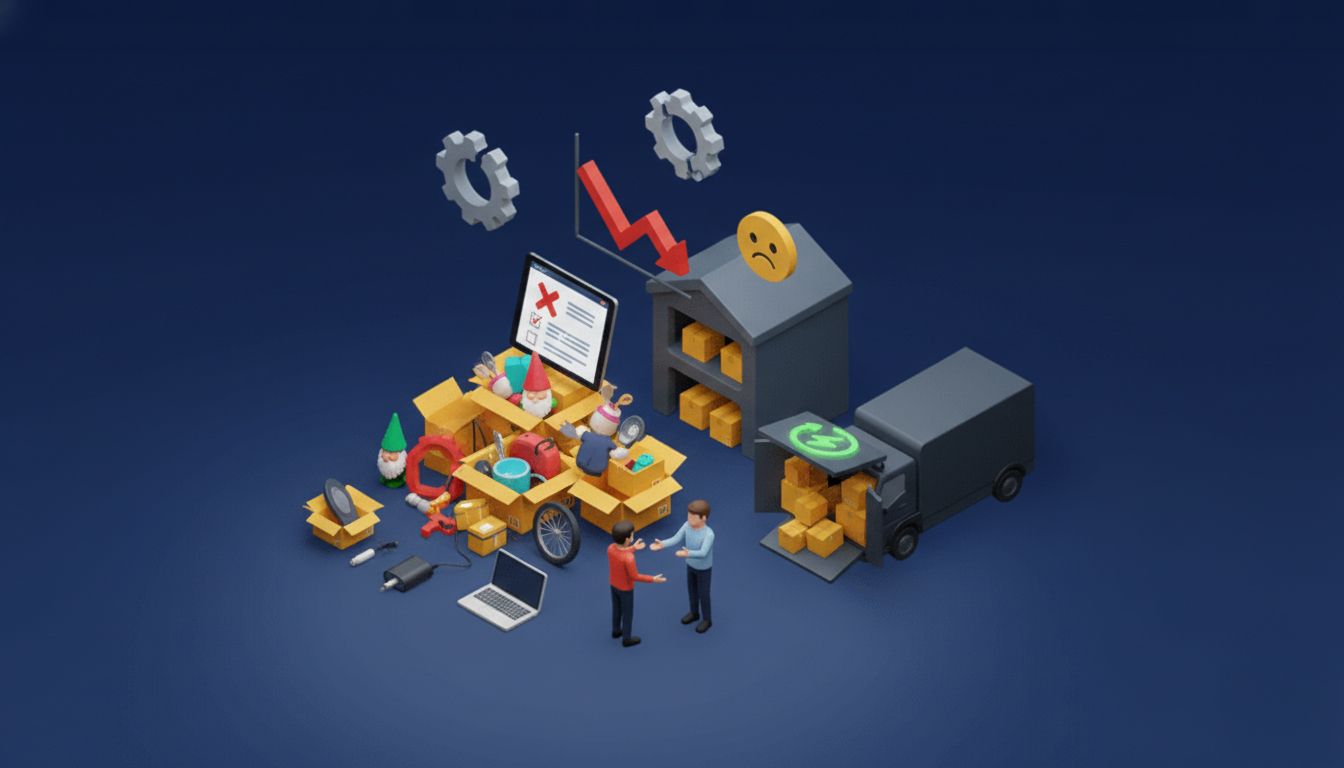Order Orchestration: Benefits & Challenges

Table of Contents
Introduction
A streamlined order management is a must if you want satisfied clients. The one thing that can help achieve this is order orchestration. From when a customer clicks Buy Now to when their package arrives on their doorstep, it integrates each stage of the order process. Order management optimization can lessen errors, accelerate delivery, and maintain sustainability. It doesn't matter if a business deals with B2B order fulfillment or serves directly to the consumer; this process makes order management and deliveries efficient.
Order Orchestration is one system that can handle various tasks such as inventory management, order routing, and customer communication. It helps in timely and cost-efficient deliveries. Order orchestration brings into one sync the multiple touchpoints and orders from all channels for companies who fulfill orders spanning online, in-store, and marketplaces. It helps businesses have a clear view of inventory and orders; this way, companies can prevent delays and stockouts to keep the customers smiling.
In this guide, we will learn about order orchestration, why it is crucial, and how tools like Omniful streamline the entire process, leaving businesses worry-free when dealing with some of the most regular pain points.
Role of Technology for Order Orchestration
It is highly relevant to leverage technology to improve the operational order orchestration while putting it into the required timing to achieve it. This means companies can track the inventory of the products in the store and, as a result, are constantly ready to sell whatever the customers want at the exact moment they need it in the store.
Automated Inventory Management also permits the firm to predict future requirements of potential customers according to history. This enables businesses to prepare themselves for the flow of clients during their peak hours because such preparations ensure that you stock the necessary products to minimize disruptions.
Another big help is in order routing. This includes electronic orders that directly go to a specific or nearest warehouse. Therefore, it reduces the delivery time and cost. That is, customers receive their orders faster. In managing orders for businesses, technology assists in simplifying processes as it connects various sales points; this helps avoid delays.
Automation as well is another advantage. It minimizes the amount of human involvement required and the risk of errors or delays occurring during each segment of the order process. Thus, it is evident that the integration of technology is quite helpful because each component works in harmony to make the process more efficient. It saves time, is mistake-free and convenient, and enhances customer satisfaction with fast delivery for seamless order fulfillment.
Benefits of Order Orchestration
Increased Accuracy
Picking, packing, and shipping are done systematically with some order orchestration for accuracy and efficiency. It reduces the chances of delays, thereby ensuring the customer receives the products within a set duration.
Faster Fulfillment
This process, also known as the Scheduling Process, goes from the initial planning stage right through to completion. It helps by locating the warehouse closest to the client and implementing fast inventory turnover that takes an extra couple of days.
Increased Customer Satisfaction
This process also gives the customer all the information about the order for better satisfaction. The order orchestration makes sure the customer is updated and satisfied with their purchase.
Cost Efficiency
The other advantage of automation is that it minimizes cost while output saves effort in the process. It decreases the time spent on labor costs and error minimization, and it costs a bit less.
Seamless Multi-Channel Fulfillment
Multi-channel order orchestration facilitates order handling across multiple channels like E-commerce sites, platforms, and retail spaces. It stores everything available in one location, thus reducing the time and stock problems.
Challenges of Order Orchestration
Here are some common challenges in implementing order orchestration and how businesses can handle them:
Integrating with Older Systems
Older systems need to be connected with new order systems. Businesses face a lot of trouble in establishing these linkages to form an order orchestration system. An older system may operate at a slower speed and with less efficiency when the new tools are used. This can slow down progress and affect order management optimization.
Managing Inventory Across Different Channels
When people wish to shop at different places, they have to worry about the amount of stock that they want to purchase; this is challenging in real-time. A stock that was in the wrong place could lead to stockouts or overselling, as both negatively affect customers' satisfaction.
Returns and exchanges
Returns and exchanges cause complexity in the customer satisfaction department. It is necessary to make sure that the customers are satisfied. To address this issue, one should seek help from specialists who deal with operations optimization. This enables an organization to accomplish multi-channel order orchestration and optimize, automate order ordering, and maintain order levels. So that companies can address the issues and improve the quality of their B2B order fulfillment.
Multi-channel Order Orchestration
Multi-channel order management assists companies in managing the different sales channels such as online stores, marketplace, and stores. One of the issues with having a wider audience engaging on other platforms is the need for more planning and inventory control for each customer. When all the orders can be put together and tracked in one place, it is called multi-channel order orchestration. There is better order management with few errors and it also helps the business in providing timely deliveries.
Another benefit of this approach is that it eliminates the possibility of stockouts and maintains consistency in supply throughout the day. The firm is in a position to assess its stock inventory levels in real-time from any sales channel where it operates, thus enabling it to determine what stock, where it is located within the operational environment, and when it has to ship the stock to get the ordered goods done quickly.
It processes the stock and thus minimizes the number of repetitive actions such as manual re-checking of stock and shipment errors. It also makes sure that the customers receive the products they ordered promptly, regardless of the sales process involved. This includes real-time updates of customer activity so that there is transparency in the tracking process. The essence of multi-channel order orchestration is critical for companies that want to develop an inventory management system and are involved in B2B order fulfillment. Setting up an order management optimization process is much easier than this, and it guarantees smooth management of sales channels.
How Omniful Solves User Pain Points
Omniful supports companies by addressing issues within the operational planning process, with more emphasis on speed, accuracy, and practicality. The other main problem is how much time and effort are needed in the process of order management. Omniful solves this by making package and pick-up efficient. The time it takes to choose items is therefore significantly reduced, thereby reducing the time to spend on selection and consequently decreasing operational costs of rapid delivery.
The main issue is the time taken to process orders. Businesses can deliver orders effectively in the least time possible with Omniful's optimized route solution. This also minimizes waste in the process. This simplifies order reception and thereby improves customer satisfaction.
Also, flexibility is a significant virtue when working with such a large volume of orders. Omniful is very flexible when it comes to managing orders. So, companies operating in the retail, logistics, and food industries organize the pallets in a way that is easily controllable and usable. This flexibility is significant in the case of B2B order fulfillment.
In Omniful, order processing across multiple channels is streamlined with a single solution to enable the business to manage its orders across multiple channel systems. It helps in reducing errors, expenses, and operational outcomes, enhancing productivity. This way, Omniful's solutions for the order orchestration process help make it convenient and trusting because fewer opportunities are introduced for delay.
Conclusion
Order orchestration is essential for businesses to manage orders from different platforms properly. Omniful can help solve the problems in implementing this process to make it simple. Request a demo now and see how Omniful helps you in seamless order fulfillment.
FAQs
-
How is order orchestration different from order management?
Order management oversees the whole order lifecycle, while order orchestration is all about automating and optimizing the fulfillment process within that lifecycle. -
Is order orchestration useful for B2B businesses?
Yes, orchestrating is essential for B2B order fulfillment as it avoids any errors, handles the orders correctly, and increases customer satisfaction.. -
What solutions are available for order orchestration?
Omnichannel Order Management Solution includes Omniful, Salesforce, and Oracle. These are suitable for different business needs. -
How does order orchestration improve customer satisfaction?
The order orchestration process makes sure that delivery speed is quicker and the probability of errors is reduced; thus, deliveries arrive faster with reduced complications.























